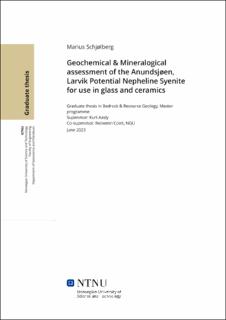Geochemical & Mineralogical assessment of the Anundsjøen, Larvik Potential Nepheline Syenite deposit for use in glass and ceramics
Master thesis

Permanent lenke
https://hdl.handle.net/11250/3101763Utgivelsesdato
2023Metadata
Vis full innførselSamlinger
Sammendrag
Sammendrag
Nefelinsyenitt er et industrimineral som brukes innen glass- og kjeramikk industrien, ettersom det tillater lavere og mer stabile smeltetemperaturer. Avhengigav dens geokjemiske sammensetning, kan den ha en positiv virkning p˚a viskositet,bearbeidbarhet og styrken av produkter den blir anvendt i. For tiden er de størsteprodusentene av nefelinsyenitt for slikt bruk i Kanada og Norge. Potensielle nefelinsyenittforekomster bør ha høy Al, Na og K innhold og lavt Fe innhold. Denneavhandlingen undersøker en potensiell nefelinsyenittforekomst nær Anundsjøen, Larvik. Forekomsten tilhører ”Ring 10” av ”Larvik Plutonic Complex”, en flerfasetintrusjon best˚aende av 10 sammenflettede intrusive enheter, ofte omtalt som ”Ring1-10”.
Prøver ble samlet i samarbeid med Norges Geologiske Undersøkelse (NGU). Prøveneutfyller to eksisterende profiler tidligere prøvetatt av NGU. Prøvene best˚ar hovedsakelig av nefelinsyenitt av foyaitt-typen, alts˚a medium kornede nefelinsyenitter medtrachytt-tekstur. To av prøvene er sterkt omvandlet og inneholder ikke nefelin. Deer derfor klassifisert som syenitter.
For˚a anse hvor vidt Anundsjøen nefelinsyenitten er anvendbar for glass og kjeramikk,ble de relevante egenskapene undersøkt, som hele prøvers geokjemi & modal mineralogi, mineralkjemi, mineralassosiasjoner og mineralogiske tekstrurer.
Prøvenes geokjemi, undersøkt via XRF, viser at nefelinsyenitten fra Anundsjøenikke er innenfor typiske krav i henhold til Fe2O3 og Al2O3 innhold, mens krav forNa2O + K2O er møtt i omtrent 2/3 av prøvene. Fe2O3 innholdet er typisk lavere idet østlige profile sammenlignet med det vestlige. XRD, konvensjonell mikroskopi,scanning-electron mikroskopi og EPMA viser at en stor andel av Fe2O3 innholdetkan separeres ved prosessering, hvilket gjør nefelinsyenitten potensielt anvendbarfor farget glass. Produkter av høy kvalitet, brukt i klart glass vil sannsynligvis ikkekunne lages. Summary
Nepheline syenite is an industrial ”mineral” which is used in the glass and ceramicsindustry, as it allows for lower and more stable melting temperatures. Dependingon its geochemical composition it can positively affect viscosity, workability andtoughness of the products it is used in. Currently, the major producers of nephelinesyenite for such use is Canada and Norway. Potential nepheline syenite depositsshould have high Al, Na and K contents and low Fe content. This thesis investigates a potential nepheline syenite found near Anundsjøen, in Larvik, southernNorway. This deposit belongs to ”ring 10” of the Larvik Plutonic Complex (LPC),which is a multiple-phase intrusion consisting of 10 nested intrusive units, commonlyreferred to as ”Ring 1-10”.
Samples were gathered from the Anundsjøen nepheline syenite, in collaborationwith the Norwegian Geological Survey (Norges Geologiske Undersøkelse, NGU). Thesamples complement two profiles previously sampled by NGU. Most of the samplesare nepheline syenites, which are of the foyaite-type, ie. medium grained nephelinesyenite with trachytic texture. Two of the samples were found to be heavily altered,containing no nepheline, and are thus classified as syenites.
In order to assess whether the Anundsjøen nepheline syenite is viable for use inglass and ceramics, key features have been investigated, such as wholerock chemistry, wholerock mineralogy, mineralogical texture, mineral associations and mineralchemistry.
Wholerock chemistry, gathered through XRF, show that the Anundsjøen nephelinesyenite do not meet typical requirements in regards to Fe2O3 and Al2O3 contents,though Na2O + K2O requirements are met in about 2/3 of the samples. The Fe2O3contents are generally lower in the eastern profile comapred to the western profile.Based on XRD, convensional microscopy, scanning-electron microscopy, automaticmineralogy and EPMA, it is likely that a large amount of Fe2O3 can be removed,potentially making the Anundsjøen nepheline syenite feasible for use in amber glass.High-quality products used for clear glass is unlikely to be achieved.